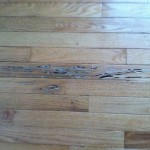Sanding Wood Floors With A Belt Sander
Sanding wood floors is a crucial step in refinishing them, whether for aesthetic improvement or structural repair. A belt sander, with its aggressive sanding capabilities, is a powerful tool for this task but requires careful handling to achieve optimal results. This article explores the process of sanding wood floors with a belt sander, covering essential techniques and safety precautions.
Choosing the Right Grit Sequence
Sanding wood floors isn't a one-step process. It involves a progressive reduction in grit size, starting with coarse grits to remove old finish and level imperfections, and gradually moving towards finer grits to smooth the surface and prepare it for finishing. A typical sequence might begin with a 36-grit, followed by 60-grit, 80-grit, and finally a 100-grit. The specific grit sequence may vary based on the condition of the floor and the desired finish. Severely damaged floors might require even coarser grits, while floors in relatively good condition might start with a higher grit. Always consult recommendations specific to the floor and finish being used.
Operating the Belt Sander Effectively
Operating a belt sander requires a balanced and controlled approach. Before starting, ensure the sander is fitted with the correct grit sandpaper and that the dust bag is securely attached. Starting the sander while it's in contact with the floor can cause gouges, so always start the motor with the sander lifted slightly. Move the sander slowly and steadily along the grain of the wood, avoiding stopping in one place as this can create dips or burns. Overlapping each pass by about half the width of the sanding belt ensures even sanding and prevents noticeable transitions between passes. Maintain a consistent pressure on the sander throughout the process, avoiding excessive force which can damage the floor. As the sanding progresses, observe the dust bag and empty it regularly to maintain optimal suction and prevent clogging.
Edge Sanding and Detail Work
While a belt sander is effective for sanding the main area of the floor, it's too large to reach corners and edges. For these areas, an edge sander or a detail sander is necessary. These smaller sanders allow for precise sanding in tight spaces, ensuring a uniform finish across the entire floor. When using an edge sander, maintain the same grit sequence as used with the belt sander. Pay particular attention to transitions between the areas sanded by the belt sander and the edge sander, aiming for a seamless blend.
Safety Precautions
Sanding wood floors generates significant dust which can be irritating to the eyes, lungs, and skin. Therefore, wearing appropriate safety gear is crucial. This includes safety glasses, a dust mask or respirator, and hearing protection. Adequate ventilation is also essential. Open windows and doors if possible, or use a dust extraction system to minimize airborne dust particles. Before sanding, inspect the floor for any protruding nails or staples and remove them to prevent damage to the sander and potential injury. Finally, remember to unplug the sander when changing sandpaper or making adjustments.
Preparing for Finishing
Once the sanding process is complete, thorough cleaning is necessary to remove all sanding dust. Use a vacuum cleaner with a brush attachment to remove the bulk of the dust, followed by tack cloths to pick up any remaining fine particles. A clean surface is essential for proper adhesion of the finish. After cleaning, inspect the floor carefully for any missed spots or imperfections. Minor imperfections can often be addressed with a hand scraper or sandpaper. Once the floor is clean and smooth, it is ready for the application of the desired finish, be it stain, sealant, or varnish.
Selecting the Right Belt Sander
Belt sanders come in various sizes and power ratings. Choosing the appropriate sander depends on the size of the area to be sanded and the level of experience. For larger areas, a heavier-duty sander with a wider belt can be more efficient. Smaller sanders are more maneuverable and generally easier to control, making them suitable for smaller rooms or less experienced users. Consider features such as variable speed control, which allows for greater control over the sanding process, particularly when working with delicate areas or different wood species.

Step By Guide To Belt Sanding Your Floors

Step By Guide To Belt Sanding Your Floors

Floor Refinishing By Trial And Error

How To Sand A Wood Floor With Belt Sander Forestry Com

Refinishing An Old Wood Floor With Only A Belt Sander And Hand Youtube

How To Properly Clean And Maintain Your Belt Sander For Optimal Performance

Step By Guide To Belt Sanding Your Floors

Floor Sanding 101 Using A Sander

Wooden Flooring Sanding Polishing By Using Belt Sander In Bengaluru Id 2853652594162

Hardwood Floor Drum Sander Vs Belt Differences







